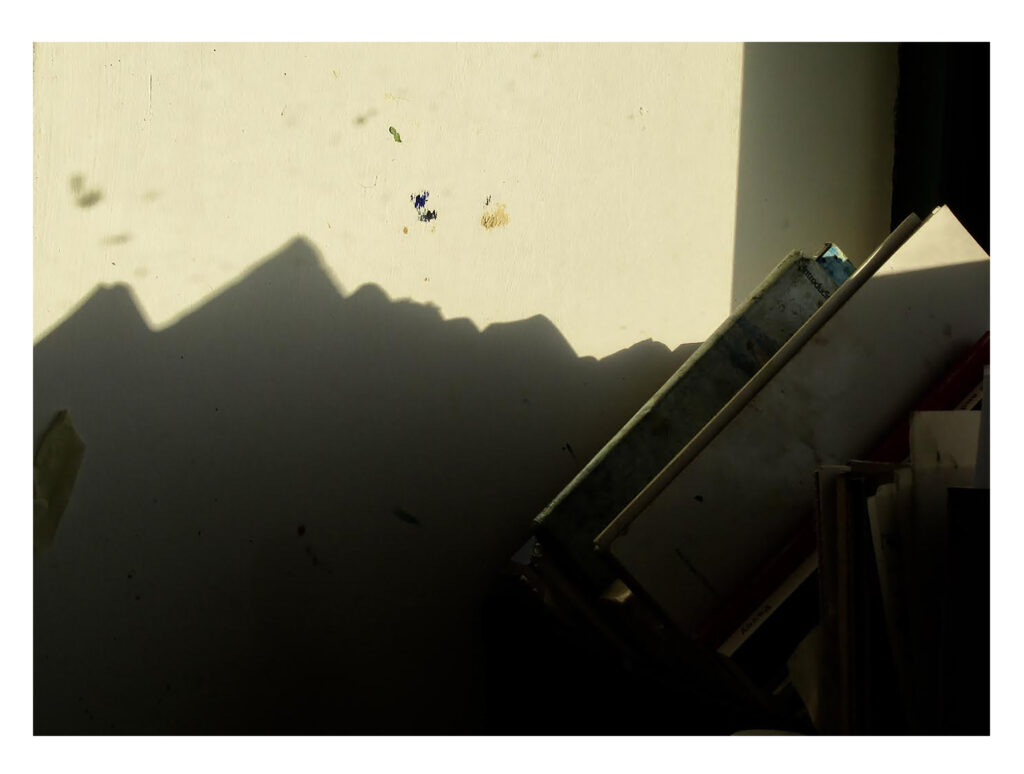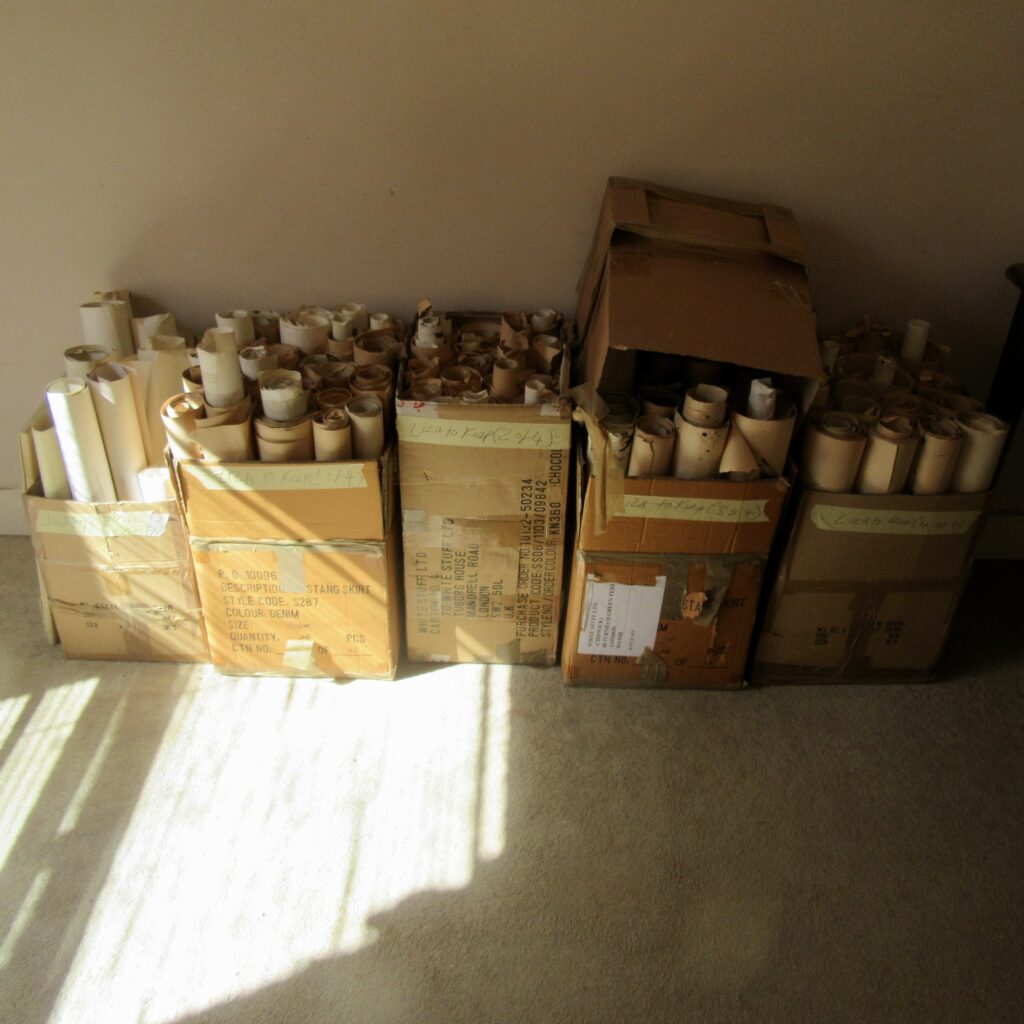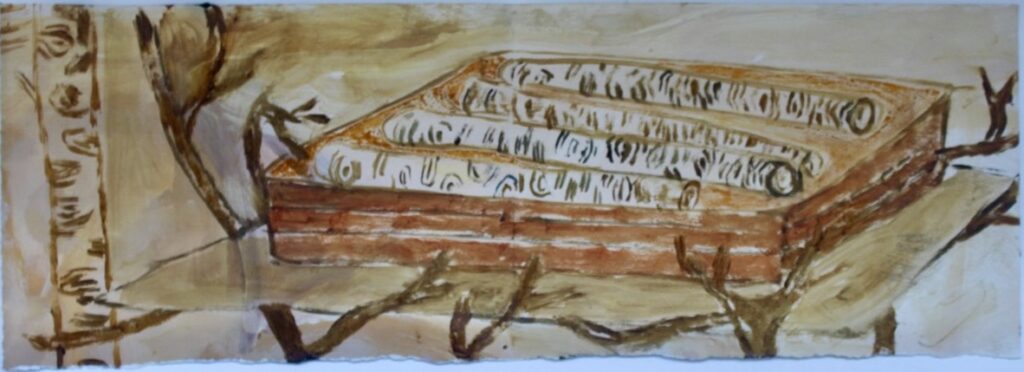Posted by Liza Dimbleby
published on : June 11, 2025

Letter from Glasgow: The Forgotten MusicRolls of drawings, thirty years old, from an attic
published on : June 4, 2025
Letter from Glasgow: The Forgotten Music
I was in a charity shop with my daughter, rummaging among old coats at the end of the rail. Suddenly a song came on — a song I knew once but hadn’t heard for ages, it was sort of Northern Soul but it soared with a refrain that came back three times and felt like free-wheeling, soaring to the edge of a landscape. It thrilled me. It gave generously. I was surprised how good it felt to be away from my desk, chancing on songs amongst old clothes. I went to the counter and paid a few pounds for a striped sheet, a check tablecloth and a cellular wool blanket, the song was free.
First published in October 2023
Letter from Glasgow: The Forgotten MusicRolls of drawings, thirty years old, from an attic
published on : June 3, 2025
Letter from Glasgow: The Forgotten Music
I was in a charity shop with my daughter, rummaging among old coats at the end of the rail. Suddenly a song came on — a song I knew once but hadn’t heard for ages, it was sort of Northern Soul but it soared with a refrain that came back three times and felt like free-wheeling, soaring to the edge of a landscape. It thrilled me. It gave generously. I was surprised how good it felt to be away from my desk, chancing on songs amongst old clothes. I went to the counter and paid a few pounds for a striped sheet, a check tablecloth and a cellular wool blanket, the song was free.
We left the shop and were walking along the pavement when I realised that I couldn’t recall the song. The strength was not its words but the tune without words and I could not hook it back in. I wondered how to find it this song without words, without a title. How could I remember it?
We went to a performance at a gallery, where daubed canvases were raised on pulleys and women were rolled up and falling out of them, to a soundtrack of looped scrapes and cries. After the earnest discussion that followed we left the gallery. Just before we left, as I was washing my hands at the toilets, the song came bouncing back to me.. All of it. I was so happy, there it was inside me and it had decided to return to me, to cheer me along. I stepped out onto the pavement humming my song. At the bottom of a stone stairwell we stopped and I sang it to my daughter’s phone, as people passed by, to an app that recognises tunes, but to no avail. The app stayed blank and pulsing. So I kept on singing it as we walked through the city to meet my friends. My daughter sang me a line of Bach back, we made a song between the two, call and response. We crossed the road to meet my friend, and then suddenly — the song was gone! It had vanished as subtly as it appeared, and I had no trace of it. I kept trying, but all I got were the more obvious, less brilliant, tunes of the era. This one was not mine to summon. I had not heard it for so many years and now I didn’t know when I would hear it again. I had no clues by which to bring it back.
I think about it inside me, biding its time, resisting my call for it — this song that so delighted me, that returned to me twice, unbidden, yesterday, and then went on its way, went back inside me, perhaps never to return. When it was there I wanted to carry it, be carried by it. I did not think of recording the notes, making a digital imprint by which to catch and hold it. I thought that it was a part of me, that it would last forever. Now I’m waiting, wondering where within me it is hiding.
First published in October 2023
War (Shelter Series), November 2021
published on : May 26, 2025
Postcard from Glasgow: Shelters
I started making these small drawings of shelters, and trees, last November, as the trees shed their yellow. They were about inhabitable spaces, in the mind’s eye, and in the drawing. I made them on torn up strips of old life drawings from twenty years ago, that I did not want to throw away, regretting the waste of good quality paper. The images kept on coming, as if wanting to be painted. When I taped them to the wall in the spring, they seemed somehow to fit the awful circumstances in which they were now situated. Not a direct depiction, but not unrelated to the bleakness. And at the same time they were about a sort of refuge, a waiting or suspension. It’s November again. And the war is relentless, still. And I am still painting shelters.
First published in November 2022
Following Letter From Glasgow
published on : May 21, 2025But I am compiling images of rooms, not streets. I am making a slide talk for the students whom I haven’t seen since February: Between the Clock and the Bed, Munch’s late painting where he stands like the grandfather clock at his side in a small room filled with his paintings, receding into the space behind him. There is a photograph of him in that same house, surrounded by the same paintings, more clearly defined by the camera. I put in a photograph of Chagall, newly arrived in Paris, sitting on the bed with his wife and daughter, and around them his landscapes of left behind Vitebsk set in the decorative curls and scrolls of drapes or carpet that have been hung on the walls of their new apartment, Russian style. They are tented in by the dark drapes, with windows only to the East.
Then there is a photograph of Bonnard, painting Marthe in the bath, canvas pinned up roughly to the wall, seemingly untroubled by the flamboyant overgrowth of the wallpaper all around it as he pursues his self-sufficient, almost immaterial world of purple, turquoise, gold within the canvas.
I sit in my room, the sheet covering the window, and I click through these images for the thirty boxes on the screen: the students, also in their rooms, these stamp sized squares, revealing slight blurs of colour or light, the indications of a surrounding in muted colours, withholding any sense of the space between us. It is the first time I have shown slides like this, to thirty separate rooms. Usually we are all in one room and every nuance, every slip or focus of attention from the viewers is palpable. But now I am not sure how to reach them, if I reach them. It is hard to judge distances.
I wanted to show images of rooms that were also about the possibility of flight from the room, of painting down the wall, opening up a new space and inhabiting it as you make it. A painting sized window out. But I wonder if this is what they want, or if the image of Bonnard pushing his brush right up against the wallpaper to make his bathroom world seems a world away. But February is a world away, and maybe Bonnard’s room is closer than ever?
It is hard to judge distances. One compensation of this hiatus we inhabit is the immediacy of reports from the past: in a film, a photograph, or in the streets that I walk through reading. The Bloomsbury squares and pavements full of incident in Virginia Woolf’s diary of 1915, or New York’s Riverside Drive in 1968 that itself gives way so suddenly to wartime Mecklenburg in Uwe Johnson’s Anniversaries. The density of sky over the Hudson summoning the banks of the left behind river close to the Baltic Sea. I read scattershot, but am able to inhabit these places more fully than ever. Time has stopped and I am less interested in a narrative arc, a drama or romance than these fixings of place; how it was, at a certain time, in a certain place; the word pictures that allow me to walk through these remote but immediate worlds.
After the talk, I leave the screen and go out for a walk, to rest my eyes. I walk up the hill on the opposite bank of the river, where the houses rise steeply. In a lane that runs between the backs of two rows of houses I am stopped by the sudden space of a high window, looking straight out through the window on the other side, as if the wall had given way into an infinite space of light and green. Is this the sort of opening I was trying to get across?
At the end of the film the hero leaves the city on a boat, and as the boat pulls out the jazz saxophone that has played throughout the film starts up again, a mordant improvisation through which emerges the drift of, yes, the familiar notes of Somewhere Over The Rainbow, stuttered and spiralling, in a minor key. I am tired of Rainbows, but this is pitch perfect. The camera hovers at the end, holding the whole of the city island in its hand. Is the boat still pulling out, or staying still?
It is hard to judge distances.
Letter from Glasgow
published on : May 20, 2025
Letter from Glasgow: BETWEEN THE CLOCK AND THE STREET
I watched the film Permanent Vacation again the other night. I didn’t pay too much attention to the words. It was this image I was after. A girl in a room, looking out. I found the shot, but it was the street scenes that held me — lower Manhattan, derelict at the end of the seventies — empty abandoned streets that are suddenly immediate, right up front and now. I want to follow these streets on and on. I imagine a film that splices together continual streets, one leading into another, from seventies New York to nineteen fifties Moscow, or Rome, or Prague and on through cities I have never walked. A continual street without end. It would be seamless, in the way that Christian Marclay so deftly spliced spiralling staircases, minute to minute, in his twenty four hour The Clock. As in that film you feel that you have to keep on walking, you can’t break off.
First published in June 2020
Letter from Glasgow: Looking Out
published on : May 20, 2025
It’s the last day of January. The low red light outside meets the red sap rising inside, in the reeds and branches on patches of unbuilt ground in this city. Red is for readiness. The year is about to kick into place and it is time to wake up. It would be tempting to stay warm inside, wrapped in the dark, looking in, but it is a swift stride from spring to autumn, the time when the lights inside go on again, to pattern the dark. It is as well to wake up now, look out, reach out for whatever presents itself in daylight. And the possibility that this might not be the same thing, that things might be said differently, heard new, seen, as if for the first time, if we allow them.
First published in January 2023
Biography
Liza Dimbleby lives in Glasgow. She has also lived in London, Paris and Moscow. She has led drawing walks in all these cities and also in Orkney and Siberia.
www.lizadimbleby.com instagram: @lizadimbleby